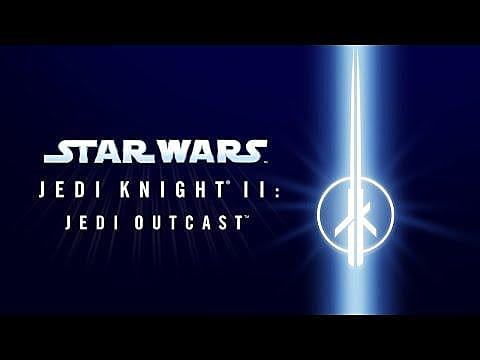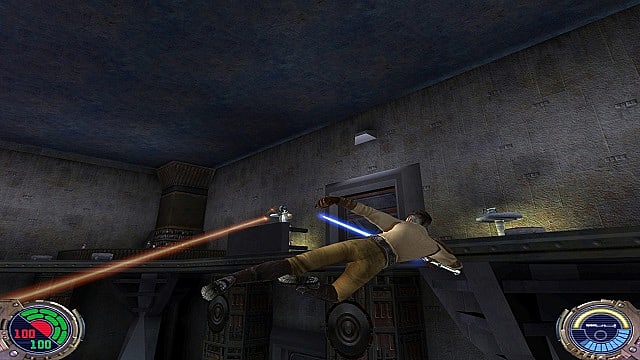

Star Wars Jedi Knight 2: Jedi Outcast is an old game. Not because that is the most obvious thing you could say about the 2002 title, but because it's the most important thing. Its age will be why some don't get past the first 15 minutes. It will also be the reason some forgive it for its shortcomings and forge ahead.
Jedi Outcast occupies a strange spot some 17 years after its initial release. Judging the game against its peers, it's one of the better action shooters from the early 2000s, and it's undoubtedly one of the better Star Wars games in the series' catalog. Though judging Outcast against modern games isn't fair considering its clunky and woefully outdated nature.
In that way, it's a mixed bag of gundarks. There's a lot of nostalgia piloting this freighter, but it's heavy and slow and mechanically ugly, even if it is still good looking after all these years.

Taking the role of a stormtrooper who can't shoot — (checks notes) oh, right: series protagonist Kyle Katarn — you fight against remnant Imperial forces some eight years after Episode 6: Return of the Jedi. You're joined in your journey to the Valley of the Jedi by pilot Jan Ors, and you run into several high-profile Star Wars luminaries, such as Mon Mothma, Lando, C-3PO, and a particular Skywalker twin.
Along the way, a circle of Sith rises to stand in your way, and threads from previous Dark Forces games weave through the plot. Ultimately, Katarn reacquaints himself with Force, gains myriad Light Side and Dark Side powers, and uses a lightsaber to slice through stormtroopers like Palp's lightning through the cold dark of the Death Star II throneroom.
In many ways, Jedi Outcast does a good job of fleshing out Star Wars lore post-Jedi. Even though its narrative is now relegated to Legends status, it's a worthwhile romp through a galaxy far, far away. Some of the game's villains should be reintroduced into Disney's new canon if for nothing more than their devilish galactic malfeasance.
While the story is good enough to drive the conceit of a Legends-era paperback by Zahn or Anderson, the rest of the game falters under the crushing weight of age.

Playing Jedi Outcast on the PS4 is sheer agony, especially in the game's initial stages. To progress, you must relearn everything you've come to know about action shooters in the modern era. Guns will not shoot the way you think they will, nor will throwables act in a reasonable manner. Adding insult to injury, Jedi Outcast isn't made for controllers, meaning aiming is inaccurate at best.
There are two ways to shoot in Jedi Outcast: single shots and burst fire. The latter works never, and the former works only in full-auto mode (read: by holding down the fire button until you run out of blaster energy). Though it's necessary to evade blaster fire, strafing complicates matters because it further decreases accuracy.
For most encounters, it's best to simply shoot stormtroopers from as far away as possible, slowly creeping toward them and stopping before triggering their movement conditions. Fail to do that, and you'll often lose dozens of minutes of progress to a quick death.
As expected, the retinue of blasters and guns at your disposal increases the more you play, though most require the same "strafe, fire, creep, fire-directly-into-stormtrooper" mechanics as all of the others. Some are series staples, like the E-11, while others expand the arsenal of Star Wars lore, such as the Tenloss Disruptor Rifle. You also gain access to throwables such as thermal detonators and placeables like mines, allowing you to mix up your tactics and strategically explode Imperial scum.

Most of these become obsolete, though, once you begin to relearn the Force, and even more so when you get your hands on a lightsaber about halfway through the game. It's a relieving change since whacking enemies with a light sword and throwing them across rooms through the power of the Whills is both more empowering and more liberating. The word "civilized" takes on greater meaning in both action and purpose when wielding something far less crude than a blaster.
Frantic fights against the Sith in Jedi Outcast rewards in spades for those determined enough to persevere through the game's early stages. While perhaps not as strategically impactful as dueling in the game's sequel, Star Wars Jedi Knight: Jedi Academy, duels here hum with the power fantasy most Star Wars fans crave.
Force powers increase the game's intensity by letting you to use both the Light Side and Dark Side of the Force. Though such a system muddles the often strict rules set upon Force users, powers such as Force Push, Force Heal, and Force Lightning work in concert to empower your actions in combat. In retrospect, the game could and probably should have put a saber and the Force in your hands much earlier, combating what's ultimately a slow slog toward them.
And that's something exacerbated by the game's inherently belligerent level design. There are times when it feels levels are overtly obtuse, opting for the angst of a Padawan instead of the sophistication of a Jedi. It's possible to spend an hour simply looking for an exit — or the lever that opens the path to the exit.

Such a framework of design is, in specific ways, what the series is known for. And this is a port after all. But it's impossible to ignore the rough, opaque edges lying at the intersection of every twist and turn.
Puzzles bring attention to the game's infamously vague design. Many are difficult to solve without a walkthrough, not to mention doing so with no in-game map or mini-map. Indeed, backtracking is both form and function in Outcast. While it is a design implemented in some of today's best games, it's clear that the archaic form found here is one bound by some ancient sorcery now lost.
Many stages are also full of traps or wide, gaping chasms. Indeed, the chances of you blowing yourself up, getting cut in half by lasers, or otherwise falling to your doom are high. Some pose as simple environmental hazards, while others are puzzles unto themselves, requiring deft movement the game doesn't inherently allow with a thumbstick.
The biggest hurdle to progress, however, is the game's stingy checkpoint system. In most ways, it's best to forget the system exists as it will do you no favors. Most checkpoints are located near the beginning of a stage. Unless you save manually as you play (read: savescum), the monotony of continually clearing the same set of rooms quickly grows tiresome.

Pros:
- Fun, frantic lightsaber combat
- Empowering Force abilities
- Well-written Legends-era story
- Still looks good today
- Kyle Katarn
Cons:
- Unfriendly checkpoint system
- Tedious, inaccurate aiming
- No option to remap controls
- No mini-map/in-game map
- Brutalist level design
It might be surprising, but Outcast is a Star Wars game I very much adore. When it initially released, it was a watershed title for Star Wars games. It improved lightsaber combat over its predecessor, and it was the midway point between old Dark Forces shooters and the more RPG-focused titles that would follow.
In that way, I look back on the game with rose-tinted glasses. Unfortunately, those glasses now have a crack running right through them. In 2019, Star Wars Jedi Knight 2: Jedi Outcast is a game laden with age. Pushing through its early stages on console is perhaps the least amount of fun you'll have in a Star Wars game. Its gunplay is stiff and frustrating. Using a controller is no substitute for a game made for mouse and keyboard. And its level design is bearish, devoid of logical and helpful checkpoints.
Unless you must absolutely play this game on console, I'd suggest sticking with the much cheaper PC port, which looks just as good and plays better. Or, perhaps, simply pick up Star Wars Jedi: Fallen Order, a game made for modern, more civilized sensibilities.
[Note: A copy of Star Wars Jedi Knight 2: Jedi Outcast was provided by Aspyr for the purposes of this review.]
0 comments:
Post a Comment